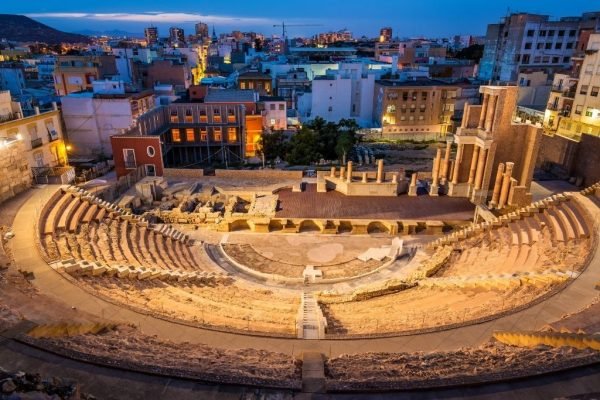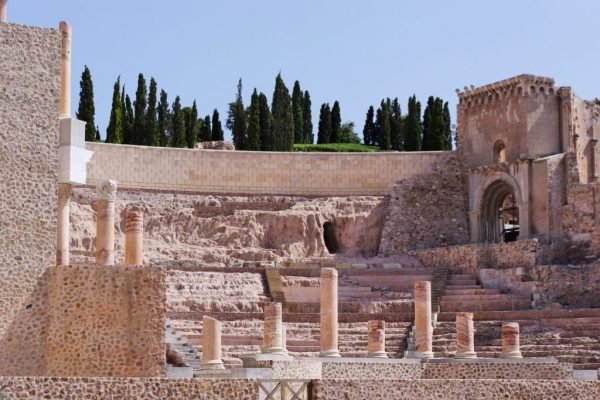Excursion to Cartagena from Roquetas de Mar, Almeria
PEPE TOURS
Excursion to Cartagena from Roquetas de Mar, Almeria
PEPE TOURS
Daytrip to Cartagena, Murcia from Roquetas de Mar
An excursion to Cartagena with Pepe Tours. Daytrip to the “Costa Calida” of Murcia in order to visit Cartagena, one of the first settlements of the Iberians accompanied by English speaking guides. Take a stroll to the old town of Cartagena, a city full of history, which was inhabited by different cultures which left their traces in a huge artistic heritage.
Departure at the indicated time from Roquetas de Mar with destination Cartagena. We will drive towards the Costa Calida, Murcia, to discover one of Spain’s most historical cities, Cartagena. We will make a city tour with our bus, along the Military Arsenal, the harbour, with a model of the first submarine, built by Isaac Peral, the Punic Wall, the Plaza de España. With a panoramic elevator we will rise towards the castle “Castillo de la Concepcion”, a high vantage point over Cartagena, from where one can enjoy beautiful views over the city. At midday there will be free time to walk along the Calle Mayor and to enjoy the modernistic buildings. In the afternoon we will drive back to the hotels. Arrival at Roquetas de Mar and the end of our service.
Departure days:
Please check availability
The excursion to Cartagena includes:
– Transportation by modern coach with air conditioning and reclining seats
– Accompanying guide service
– Guided tour of Cartagena
– Visit the Conception Castillo in Cartagena
– Travelers insurance
Price details
| PRICE PER PERSON IN EUROS (SEASON 2025 - 2026) | |
| ADULT | from 72 € |
| CHILD (3 – 11 years) | from 25 € |
More information about Cartagena:
The harbour of Cartegena, at the Costa Calida, has been appreciated since the time of the Carthaginians. The city has been populated by different cultures because of its strategic position at the coast of Murcia. These cultures have left behind their influence on the artistic heritage of Cartagena. A walk through the city and its museums takes us into the history of a city closely united with the sea.
Carthaginians and Romans were always interested in this maritime enclave which actual name comes from the Latin name Cartago Nova. Cartagena was also dominated by the Arabs until Ferdinand III The Saint reconquered the city and it was integrated in the Kingdom of Castile. The harbour has played an important role in the Spanish War of Succession and the War of Independence.
The rich heritage of Cartagena runs along the quay of the marina. The Muralla del Mar (the Wall of the Sea), built by order of Charles III (in the eighteenth century), defines the old centre. Towards the Mediterranean Sea two elements of a close relationship with the sea can be found: the prototype of a submarine constructed by the Carthaginian inventor Isaac Peral, and the National Museum for Maritime Archaeology. This Museum, located on the Dique de Navidad, also contains the National Center for Archaeological Submarine Investigations. Through different foundings we can learn the aspects of shipbuilding, trade and navigation in ancient times.
The Punic Wall was discovered in 1989. Its construction dates back to the year 227 b.C. when the Punic city of Quart Hadast was founded. It is a fortification to Hellenistic model, formed by two parallel walls with a mutual distance of 6 meters, connected with each other by other walls. The Punic city was shut by this construction, as it formed a part of the isthmus, the only access to the city.
The entrance to the city is dominated by the Palacio Consistorial, also called Ayuntamiento, the City Townhall, a jewel of modernistic architecture of the beginning of the twentieth century. Walking towards the Parque Torres (behind the Muralla del Mar) we will reach the Cathedral. It is the oldest temple of Cartagena (thirteenth century), whose remnants were preserved on top of the stand of the Roman Theatre, discovered in 1987. This construction dates back to the first century before Christ and it is one of the most important roman theatres in Spain, together with the theatre in Merida. The Municipal Archaeological Museum shows many of the pieces that were found during the excavations, such as altar stones, reliefs and sculptures. Good examples of the roman splendour are the remnants of the amphitheatre (in the bullring), the archaeological site called El Molinete, the colonnade of the “Moreria Baja” and the Byzantine Wall, which, in spite of its name, is also roman. In the Parque Torres rises the castle “Castillo de la Concepcion”. Situated on top of a hill it has been a fortress for Carthaginians, Romans, Visigoths, Arabs and Spaniards.
To know the modernistic architecture of Cartagena one has to make a walk along the Calle Mayor, which starts at the Plaza del Ayuntamiento. Here we find the Houses Cervantes and Llagostera, works of the Carthaginian architect Victor Beltri, whose characteristic elements are viewpoints, works in iron and bronze reliefs of allegoric figures. The Casino, the Gran Hotel, the Railway Station and the Houses Maestre and Dorada are also representative buildings for this artistic movement.
Elegant and civic monuments that tell us about the economic development of the region based on mining and industry at the end of the 19th and the beginning of the 20th century. The Palaces of Aguirre and Pedreño are more aristocratic, one with a more modernistic style, the other one with a more neoclassic style.
Next to the walled Old Town the Military Arsenal is situated, built during the government of Charles III. In these walls we can find the only gate which was left. One can also visit the Maritime Museum, located on the limits of the modern city and also connected with the history of Cartagena. Here we can see navigation instruments of old ships, charts and navigation maps, next to models of all kind of ships. The fishing district Santa Lucia is also worthwhile to pay a visit.
The diversity in the landscape of the Region of Murcia enriches also the gastronomy, where products of the horticulture, the sea and the inland go hand in hand. In Cartagena there is no doubt about the predominance of salted fish, fresh fish, stews and paellas. The many saltlakes of the Mediterranean Sea are used to prepare salted fish (specially tuna fish and different kinds of mackerel) and the fish “a la sal” (fish in the oven, cooked under a layer of salt) such as bream. The stews with mullet, sea devil, dentex… accompanied with rice cooked in the same pot, and garnished with alioli sauce. The fig bread is a specialty of the region, and the “asiatico”, property of Cartagena “delights” the coffee with condensed milk, brandy and cinnamon.
Please note that
* Pepe Tours reserves the right to change the itinerary and the order of the excursions for organizational reasons.







